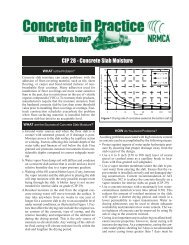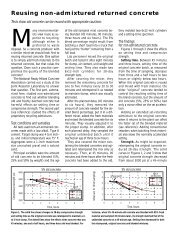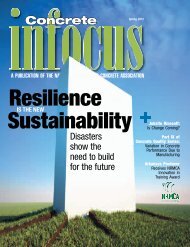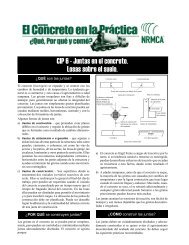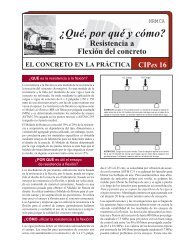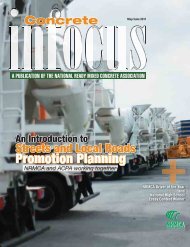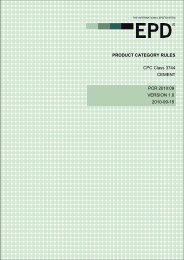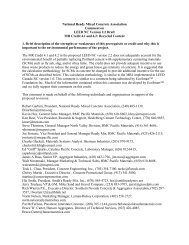2010 NRMCA - National Ready Mixed Concrete Association
2010 NRMCA - National Ready Mixed Concrete Association
2010 NRMCA - National Ready Mixed Concrete Association
Create successful ePaper yourself
Turn your PDF publications into a flip-book with our unique Google optimized e-Paper software.
tech talkVariation in <strong>Concrete</strong> StrengthDue to Water and Air Content VariationPart IV of <strong>Concrete</strong> Quality SeriesBy Karthik Obla, Ph.D., P.E., VP, Technical Services, <strong>NRMCA</strong>Parts I and II of the <strong>Concrete</strong> Qualityseries 1,2 discussed that to attain goodconcrete quality a concrete producerneeds to target a low standard deviation ofcompressive strength. In order to reduce thestrength standard deviation the material,manufacturing and testing variations needto be lowered. This article discusses concretestrength variability due to variation inwater and air contents.Water Content Variation and itsEffect on Strength VariationCompared to other ingredients, thereare several sources (and potential errors)by which mixing water is incorporated ina concrete mixture. These sources and waysto ensure that the batch water is withintolerance of the designed amount will bediscussed in a later article. ASTM C94 3and ACI 117 4 state that the total mixingwater should be within ±3% of the quantityrequired by the mix design. ASTM C94also requires that the added water should bewithin ±1% of the design total mixing water.These standards do not establish accuracyrequirements for individual sources of water,such as for water added from the water tankon the concrete truck. The <strong>NRMCA</strong> PlantCertification inspection process has accuracyrequirements for water measurement inthe plant and for water tanks that are basedon target quantities. For the purpose of thisdiscussion, it is assumed that for plants andconstruction practices operating under agood standard of control the mixing watercontent can vary within ±5% of the requiredquantity 95% of the time. In other wordsfor a concrete mixture with a design mixingwater content of 250 lb/yd 3 , the actual watercontent can vary by ±12.5 lb/yd 3 .During a field evaluation conducted by<strong>NRMCA</strong> the mixing water content calculatedfrom the batch records and otherreported sources of water was found to rangefrom 227 to 256 lb/yd 3 with an average of243 lb/yd 3 . This was determined from 12loads of the same mixture. From this evaluation,94% of the values were within the rangeof ±12.5 lbs. One could also consider theASTM C94 and ACI 117 allowable slumptolerance of ±1.5 in. (for concrete of slumpgreater than 4 in.), with all else being equal,as roughly resulting from a ±5% variation inwater content. As part of a different studythe author received project test data fromseveral concrete producers. Each project testdata consisted of slump, air content, temperature,7 and 28 day strengths measuredon the same concrete sample over a period ofseveral months. Some of that data are summarizedin Tables 1-3. Table 1 shows thatbarring Producer C the remaining four datasets met the slump requirement within toleranceexceeding 95% and averaged 96.3%.So, the assumption that plants and constructionpractices operating under a good standardof control have a mixing water contentvariation of ±5% of the required quantity95% of the time seems reasonable.For a concrete mixture at a given w/cm, a±5% variation in mixing water will have thesame effect on the w/cm as a ±5% variationin the cement content. A commonly usedrule of thumb is that one pound of cementequates to a compressive strength between8 to 12 psi. (This is a simplistic assumptionthat is valid only for w/cm around 0.50 to0.60 or for concrete with 28-day compressivestrength ranging from 4000 to 5000 psi;for lower w/cm concrete, a pound of cementcontributes lesser to compressive strength ascompared to higher w/cm – see AppendixA for more discussions). This means that a±5% variation in cement content will resultin a ±5% compressive strength variation(based on the discussions in Appendix Athis is valid only for w/cm around 0.50). Ifthe mixing water content varies by ±5% ofthe target value 95% of the time, the effectis that the resulting compressive strengthvariation should be within ±5% of the averagestrength 95% of the time.Air Content Variation and itsEffect on Strength VariationASTM C94 and ACI 117 state thatfor air entrained concrete the tolerance is±1.5%. Table 2 has only two data sets withair entrained concrete. Both the data setsshow that there is a higher compliance withair content tolerances compared to slumptolerances. Based on that data one couldconservatively assume that for plants andconstruction practices operating under agood standard of control the air contents ofair entrained concrete can vary within ±1.5%of the average 95% of the time. Table 2 has3 data sets with non air entrained concrete.ASTM C94 and ACI 117 do not state tolerancesfor non air entrained concrete. Theair content variations in non air entrainedconcrete are expected to be lower than in airentrained concrete. Assuming a tolerance of±0.75%, the 3 data sets show that for plantsand construction practices operating undera good standard of control the air contents ofnon air entrained concrete can vary within±0.75% of the average 95% of the time.A common rule of thumb is every 1%increase in air content will reduce the concretecompressive strength by 5%. So the aircontent variation of ±1.5% will result in aCONCRETE in focus ı 29



